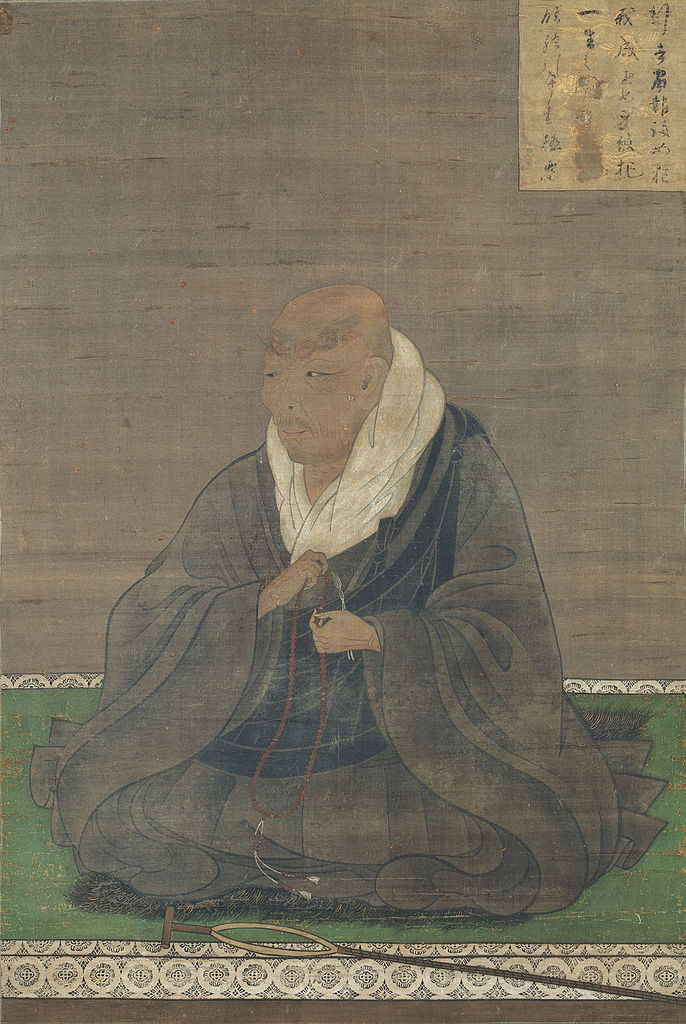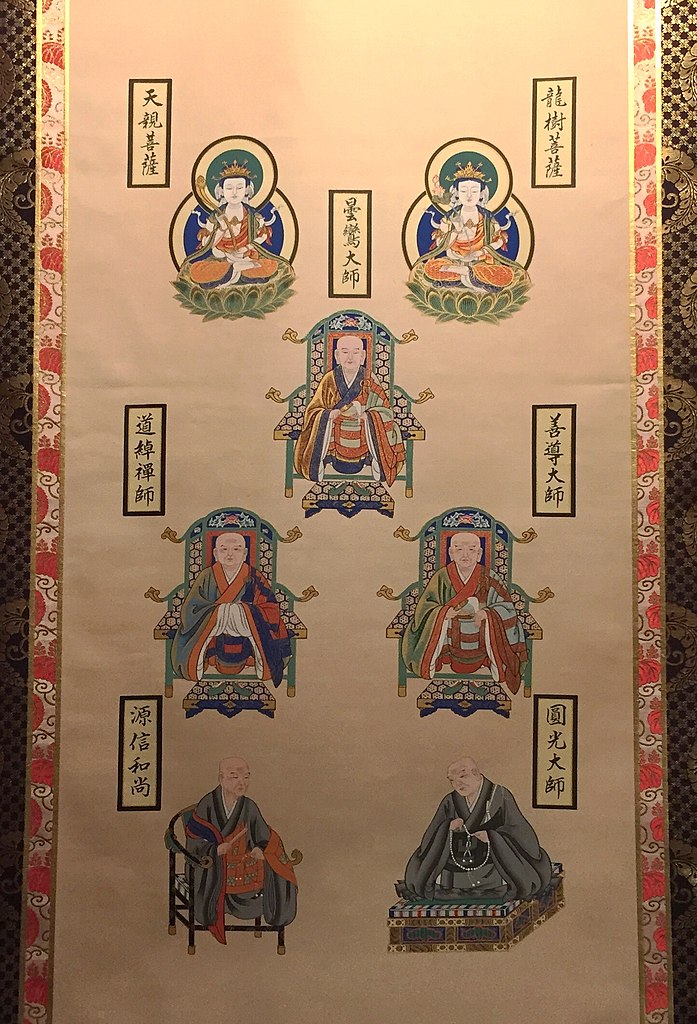
Shinran (1173-1262), started out just as Honen had forty years before with a period of training on Mt Hiei during which he became disillusioned, as he felt he was making no progress. Even his practice of the nenbutsu as Ennin had established it, which involved circumambulating Amida’s image while invoking his name and visualising his Pure Land, had led him nowhere. Then, in 1201, “according to an account written later by his wife Eshin-ni, Shinran had been visited by the spirit of Shotoku, whom he considered an embodiment of Kannon … advising him to find a master in the Pure Land tradition … Shortly after, he met Honen.”
Honen had taught that in the Degenerate Age, humans had lost the ability to attain enlightenment through their “own-power” (jiriki), so the only path now open to us was that of “other-power” (tariki). This other-power was that embodied in Amida’s Vow, which would ensure a rebirth in Amida’s Pure Land and ultimately result in enlightenment. The practice required our entrusting ourselves to Amida’s Vow, and the recitation of the nenbutsu, as described in the lines Honen had read in Shandao’s “Commentary on the Meditation Sutra”: “Exclusively repeat the Name of Amida with a single-hearted devotion … never ceasing for even one moment.” Shinran became Honen’s close disciple for the next six years.
Kasulis tells us that “in 1207 the imperial government issued a ban on preaching the Nenbutsu religion in the capital, beheading four of Honen’s followers, two of whom had apparently become too influential on a pair of the emperor’s ladies-in-waiting. The emperor also exiled key figures in the movement, including both Honen and Shinran, Honen to the island of Shikoku and Shinran to the Echigo area in northern Honshu. The teacher and student never saw each other again.”
Shinran then decided to abandon his monastic vows of celibacy, and married. When the ban ended five years later, Honen had died and Shinran was in no hurry to return to Kyoto. Instead he moved to the rural Kanto area near Kamakura, where he shared the simple life of commoners and outcastes. “Just a couple of years after his departure from the region, the military government banned the Pure Land religion in Kamakura, presumably alarmed by its increasing popularity.”
Shinran embarked on what he saw as a development of Honen’s teachings. But, “it soon became evident that Shinran’s thought had diverged sharply from that of Honen’s other disciples, creating differences that triggered a schism in which Shinran’s supporters called themselves the “True Pure Land Sect” (Jodo Shinshu or just Shinshu) to distinguish themselves from Honen’s “Pure Land Sect” (Jodo-shu).” In the English-speaking world, Jodo Shinshu is often referred to as Shin Buddhism.
Shinran did in fact go much further and deeper, not only into Pure Land philosophy, but also into issues that had been faced by all schools of Buddhism in connection with its fundamental contradiction between the assertion that there is no such entity as the self understood as an “agent,” that is, endowed with intrinsic ontological existence, and the expectation that practitioners in most schools of Buddhism embark on a path of practice seemingly carried out by the “self,” as it relies on our “self-power.” How could the illusory separate self practice something in order to reveal that it is illusory?
Before throwing himself into his own enquiry, Shinran had followed Honen’s guidance to the letter, and attained full enlightenment. In Shinran’s own words: “As for myself, Shinran, I simply receive the words of my dear teacher, Honen, “Just say the nenbutsu and be saved by Amida,” and entrust myself to the Primal Vow. Besides this, there is nothing else” (Tannisho).” So that was his practice. No philosophical inquiry was involved. The philosophical inquiry came later, after he had attained his goal.
To start with, Shinran asked: “why was it that the Path to Self-perfection had failed for both Honen and himself? Kasulis writes: “Shinran came to identify the problem as one of hakarai, the calculative thinking and weighing of logical alternatives that characterised the philosophical reasoning behind the Path to Self-perfection. Being egoless and free of distortions and delusions, a buddha can engage in hakarai effectively. But we ordinary people, bound up as we are with karmic afflictions and crippled with delusions cannot.”
Both jiriki (own-power) and hakarai, as the impulse to “figure things out” through the intellect, require that one separate one’s self from either its goal of practice or its object of thought. “In other words, in both praxis and theory, the Path to Self-perfection assumes a discrete, detached self. That, says Shinran, is the fatal flaw in any system trying to follow the Path to Self-perfection.” Kasulis sums up Shinran’s argument as follows: “The Path to Self-perfection, the Path to enlightenment undertaken through my own efforts, assumes that ‘I’ can know and ‘I’ can undertake the self-liberating praxis leading to enlightenment. Because of karmically determined afflictions, any appearance of the ‘I’ is tainted by egocentrism and selfishness – the only ‘I’ one can have is an ego-based ‘I’. Yet, enlightenment is by definition egoless (muga). Therefore by its own logic, the Path to Self-perfection cannot result in enlightenment.”
In his development of Honen’s teaching concerning the Gate to the Pure Land, Shinran’s goal was to ensure that his praxis “contained absolutely no residue of self-effort.”
Shinran’s Metapraxis
Separated by exile from Honen, a teacher he deeply admired and learned from for seven years, Shinran embarked on a remarkable existential inquiry, based on his own experience of awakening, of the daunting issue of faith. How do we surrender our ego-selves to truly entrust ourselves to another power?
Shinran’s starting statement was:
“As for myself, Shinran, I simply receive the words of my dear teacher, Honen, “Just say the nenbutsu and be saved by Amida,” and entrust myself to the Primal Vow. Besides this, there is nothing else.” But now, Kasulis gives us the full quote. “I really do not know whether the nenbutsu may be the only cause for my birth in the Pure Land, or the act that shall condemn me to hell. But I have nothing to regret, even if I should have been deceived by my teacher, and, saying the nenbutsu, fall into hell. The reason is that if I were capable of realizing Buddhahood by other religious practices and yet fell into hell for saying the nenbutsu, I might have dire regrets for having been deceived. But since I am absolutely incapable of any religious practice, hell is my only home” (Tannisho).
This is a rather dramatic statement. Deliberately so. Shinran was keen to deny that the entrusting in other-power was a “choice,” which would involve a “self” making the decision. “To entrust in other-power is not a choice, but a response to having no alternative, precisely the situation of not having a choice.” Furthermore, “Shinran does not claim to have “figured out” anything. Having given up, he just follows what he heard from Honen. Shinran himself does not claim to know he is right. Therefore, he did not arrive at the Pure Land Gate through any reasoning process. No hakarai [calculative thinking] was involved. Any recourse to hakarai is “an earmark of depending on one’s own power.”
Kasulis writes: “To be consistent with his own theory, Shinran could not come to his conclusion through logical argument. Yet, he could nonetheless describe and analyze his (and our) situation.” I take this to mean that Shinran is simply sharing his own experience of awakening, in particular how it was triggered.
Because of the “karmically determined afflictions (bonno) permeating the human condition … we do not realize that the ego which wants to control our spiritual release from attachment is itself the cause of attachment: the desire to be free of desire subverts its own mission precisely because it is a desire by the ego to improve its own situation. Upon recognizing the catch-22, we quit trying.”
“What Honen discovered and Shinran elaborated, however, was that in giving up we can be saved from our delusion. But only if we give up entirely, without the least trace of doing it as a means to save ourselves. In that case we are liberated from our delusions not because we have given up, but the giving up itself is being liberated. Put more boldly, salvation (namely the assurance of rebirth in the Pure Land) is not the response to despair; salvation is another name for despair, at least despair of the right sort.” The successful entrusting of oneself to the Vow of Amida is referred to as “shinjin awakening.” Attaining shinjin guarantees that you will be reborn in the Pure Land and attain enlightenment.
So it is at the very moment that we quit trying and give way to despair that we truly surrender and attain enlightenment. “Enlightenment is inseparable from anguish: in anguish itself we should be able to discover enlightenment. In other words, enlightenment does not escape anguish; it engages it.”
This is an experience that is found in quite a few accounts of individuals having at least caught a glimpse of enlightenment. In some cases, it is recounted as having occurred spontaneously at a time when the individual had no particular interest in spirituality, and it had been the event that had led them to later engage in a Buddhist practice. Deep anguish and despair can lead to a sudden release during which, as it were, your sense of self dissolves, you are everywhere, and nowhere in particular, and you feel complete and completely safe. Zen philosopher Nishitani Keiji built his entire philosophy on the way a nearly suicidal feeling of nihilism led him through a double negation of things (that had become meaningless for him) and self, exploding under the pressure of this meaninglessness, to an affirmation of both things and self on the field of “be-ification,” which he equates with the field of emptiness.
“In engaging our anguish instead of ignoring or trying to transcend it, we experience the power of Amida’s vow.” To help us, Shinran explains (in Kasulis’ words): “To fathom the working of one’s karmic afflictions and the resultant anguish is to fathom the working of Amida’s vow … Where there is anguish, there is the working of Amida’s vow. Where this is no anguish, there is no working of the vow. So, it is literally impossible to feel joy – the lack of anguish – over the fact that Amida’s vow has assured our rebirth in the Pure Land. The working of the vow only exists where there is anguish.”
Also, and this helps clarify the meaning of one of Shinran most intriguing passages: “Since our own personal anguish is the anguish we can truly know … we experience the working of Amida’s vow only within ourselves. That explains one of Shinran’s famous passages from the epilogue to Lamenting the Deviations: “When I ponder on the compassionate vow of Amida, established through five eons of profound thought, it was for myself, Shinran, alone. Because I am a being burdened so heavily with karma, I feel even more deeply grateful to the Primal Vow which is decisively made to save me.”
In other words, “even our entrusting ourselves to Amida’s vow is itself the working of Amida’s vow in us.” Then, “Amida’s compassion will express itself through us as spontaneous moral activity … I would have to see it as not my act at all, but rather the working of Amida’s compassionate vow.”
Source: Thomas P. Kasulis: Engaging Japanese Philosophy

